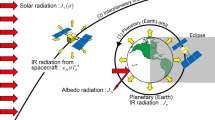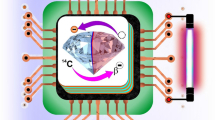Abstract
The article presents the concept of a universal space platform with a propulsion system based on water electrolysis. The spacecraft based on the platform is used for an asteroid research mission. The mission task is to extract water from the target asteroid and refuel the spacecraft. The requirements for such a performance of a universal space platform are proposed. The advantages and disadvantages of using such propulsion systems in small spacecraft are highlighted.




Similar content being viewed by others
Code availability
All code can be found at https://github.com/Zebrushka/universal-space-platfrom-trajectory.
Data availability
Not applicable.
References
Fedorov V, Vaganov I, Peshkov R (2019) Use of transport-energy and landing modules for research of small space objects. In: Young Researcher: Proceedings of the 6th scientific exhibition-conference of scientific-technical and creative works of students, vol 6, pp 460–469
Parness A (2011) Anchoring foot mechanisms for sampling and mobility in microgravity. In: 2011 IEEE international conference on robotics and automation. IEEE, Shanghai, pp 6596–6599
Pothamsetti R, Thangavelautham J (2016) Photovoltaic electrolysis propulsion system for interplanetary CubeSats. In: 2016 IEEE aerospace conference, pp 1–10. https://doi.org/10.1109/AERO.2016.7500829.
Rubanenko L, Venkatraman J, Paige DA (2019) Thick ice deposits in shallow simple craters on the Moon and Mercury. Nat Geosci 12:597–601. https://doi.org/10.1038/s41561-019-0405-8
Hemingway D, Iess L, Tajeddine R, Tobie G (2018) The interior of Enceladus. In: Enceladus and the Icy Moons of Saturn, University of Arizona, Tucson, pp 57–77. https://doi.org/10.2458/azu_uapress_9780816537075-ch004
Krejci D, Lozano P (2018) Space propulsion technology for small spacecraft. Proc IEEE 106:362–378. https://doi.org/10.1109/JPROC.2017.2778747
Jewitt D, Guilbert-Lepoutre A (2012) Limits to ice on asteroids (24) Themis and (65) Cybele. Astron J 143(1):21. https://doi.org/10.1088/0004-6256/143/1/21
McKay AJ, Bodewits D, Li J (2017) Observational constraints on water sublimation from 24 Themis and 1 Ceres. Icarus 286:308–313. https://doi.org/10.1016/j.icarus.2016.09.032
Zacny K, Chu P, Craft J, Cohen M, James W, Hilscher B (2013). Asteroid mining. In: AIAA SPACE 2013 conference and exposition. https://doi.org/10.2514/6.2013-5304
James WW, Zacny K, Craft J, Chu P, Cohen MM (2014) Robotic asteroid prospector (RAP) NIAC phase 1 results. In: Proceedings of the 7th symposium on space resource utilization AIAA. https://doi.org/10.2514/6.2014-0500
Lemeshevskii S, Graphodatsky O, Shirshakov A, Moskatiniev I, Mitkin A, Baliyev A (2018) Space transport systems for industrial and scientific development of small celestial bodies. Vestnik NPO im. S.A. Lavochkina 2(40):47–55
Gates M et al (2015) The asteroid redirect mission and sustainable human exploration. Acta Astronaut 111:29–36. https://doi.org/10.1016/j.actaastro.2015.01.025
Andrews DA et al (2015) Defining a successful commercial asteroid mining program. Acta Astronaut 108:106–118. https://doi.org/10.1016/j.actaastro.2014.10.034
Calla P, Fries D, Welch C (2018). Asteroid mining with small spacecraft and its economic feasibility. arXiv: Instrumentation and methods for astrophysics
Wiens J, Bommarito F, Blumenstein E, Ellsworth M, Cisar T, McKinney B, Knecht B (2001) Water extraction from martian soil. https://www.lpi.usra.edu/publications/reports/CB-1106/csm01.pdf
Kornuta D et al (2019) Commercial lunar propellant architecture: a collaborative study of lunar propellant production. REACH 13:100026. https://doi.org/10.1016/j.reach.2019.100026
Wertz JR, Larson W (2013) Space mission analysis and design, 3rd edn. Springer Netherlands
Frost C et al. (2015) Small spacecraft technology state of the art. NASA Ames Research Center. https://www.nasa.gov/sites/default/files/atoms/files/small_spacecraft_technology_state_of_the_art_2015_tagged.pdf. Accessed 4 May 2021
Zacny K, Paulsen G, McKay CP, Glass B, Dave A, Davila AF, Mellerowicz MM, Heldmann B (2013) Reaching 1 m deep on mars: the icebreaker drill. Astrobiology 13(12):1166–1198. https://doi.org/10.1089/ast.2013.1038
Schmitz PC, Mason LW, Schifer NA (2016) Modular stirling radioisotope generator. In: U.S. National Aeronautics and Space Administration, NASA/TM-2016-218911. http://large.stanford.edu/courses/2018/ph241/long1/docs/nasa-tm-2016-218911.pdf
Barbee B, Esposito T, Piñon E, Hur-Diaz S, Mink R, Adamo D (2010) A comprehensive ongoing survey of the near-Earth asteroid population for human mission accessibility. In: Proceedings of the AIAA/AAS astrodynamics specialist conference
Schwertheima A, Knolla A (2020) The water electrolysis hall effect thruster. In: Proceedings of the 71th international astronautical congress (IAC)
Zacny K, Chu P, Craft J, Cohen M, James W, Hilscher B (2013) Asteroid mining. In: AIAA SPACE 2013 conference and exposition. https://doi.org/10.2514/6.2013-5304.
Funding
The research was funded by the Ministry of Education and Science of the Chelyabinsk Region.
Author information
Authors and Affiliations
Contributions
All authors contributed to the study’s conception and design. Material preparation, data collection and analysis were performed by MS. The first draft of the manuscript was written by MS and all authors commented on previous versions of the manuscript. All authors read and approved the final manuscript.
Corresponding author
Ethics declarations
Conflict of interest
The authors declare that they have no conflict of interest.
Rights and permissions
About this article
Cite this article
Shalashov, M., Fedorov, V., Vaulin, S. et al. Concept of application of water electrolysis propulsion system as a component of a universal space platform for asteroid exploration mission. AS 5, 159–165 (2022). https://doi.org/10.1007/s42401-021-00110-0
Received:
Revised:
Accepted:
Published:
Issue Date:
DOI: https://doi.org/10.1007/s42401-021-00110-0




